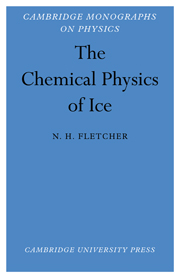Book contents
- Frontmatter
- Contents
- Preface
- Note on Units
- CHAPTER 1 The water molecule
- CHAPTER 2 Structure and energy of ordinary ice
- CHAPTER 3 Other forms of ice
- CHAPTER 4 Liquid water and freezing
- CHAPTER 5 Crystal growth
- CHAPTER 6 Thermal properties and lattice dynamics
- CHAPTER 7 Point defects
- CHAPTER 8 Mechanical properties
- CHAPTER 9 Electrical properties
- References
- Subject Index
CHAPTER 7 - Point defects
Published online by Cambridge University Press: 21 May 2010
- Frontmatter
- Contents
- Preface
- Note on Units
- CHAPTER 1 The water molecule
- CHAPTER 2 Structure and energy of ordinary ice
- CHAPTER 3 Other forms of ice
- CHAPTER 4 Liquid water and freezing
- CHAPTER 5 Crystal growth
- CHAPTER 6 Thermal properties and lattice dynamics
- CHAPTER 7 Point defects
- CHAPTER 8 Mechanical properties
- CHAPTER 9 Electrical properties
- References
- Subject Index
Summary
So far in this book we have been concerned almost entirely with the properties of perfect crystals of ice. The properties discussed were, in fact, not structure–sensitive and both the theory and necessarily the measurements apply equally to real crystals. In the remaining chapters, however, we shall examine attributes of ice which do depend sensitively upon the perfection of the particular crystal involved. There are many imperfections which occur in real crystals—surfaces, impurities, dislocations, vacancies and so on—with which we shall necessarily be concerned but in the present chapter we focus attention on the various possible kinds of point defects.
The structure of a perfect ice crystal is, as we have seen, of a statistical kind in which many different configurations are allowed provided they satisfy the three rules: (i) each lattice position is occupied by a water molecule tetrahedrally bonded to its four nearest neighbours; (ii) water molecules are intact so that there are just two protons near each oxygen; (iii) there is just one proton on each bond. Violation of the first rule leads to a vacancy, an interstitial or an impurity atom, while violation of the second or third gives rather more subtle defects peculiar to the ice structure. The very existence of these rules implies an energy penalty for their violation but, in any real crystal at a finite temperature, there will be a Boltzmann probability for finding such exceptions.
- Type
- Chapter
- Information
- The Chemical Physics of Ice , pp. 147 - 164Publisher: Cambridge University PressPrint publication year: 1970
- 1
- Cited by



